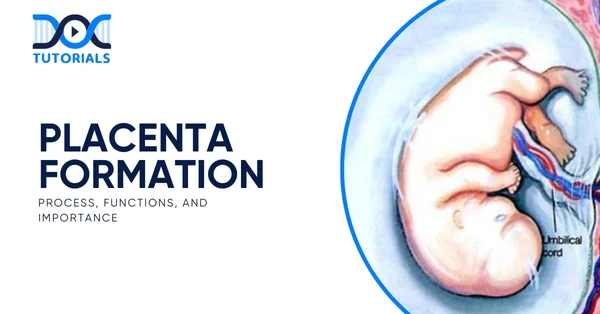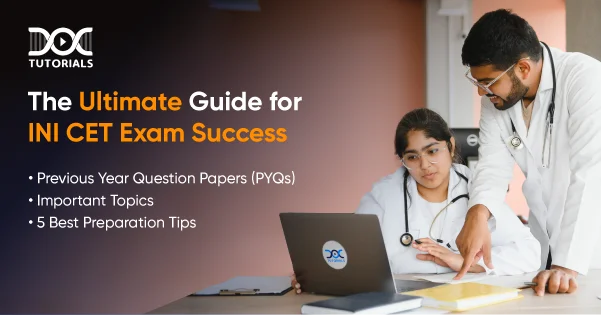Placenta Formation: Process, Functions, and Importance

The placenta, also called the “lifeline” between mother and baby, is a transitory organ that helps keep the delicate balance of caring for a growing foetus.
The placenta is made up of both maternal and foetal tissues, and in the early stages, it gets help from the yolk sac. It lets nutrients pass between the mother and the baby and makes sure the baby grows inside the womb.
It also secretes vital hormones that ensure the continuity of pregnancy and foetal development. For medical students who are about to appear for competitive exams such as NEET PG, understanding the process of placenta formation is important. Here is a comprehensive guide to clarify this process for you.
What is a Placenta?
The placenta is a transient organ that forms in the uterine cavity throughout pregnancy, linking the foetus and mother through the umbilical cord. This organ is formed by the trophoblast layer of the blastocyst and partly by the yolk sac, which contributes towards early nutrition.
The placenta also supplies oxygen and nutrients to the foetus, removes waste products, and transfers maternal antibodies. Serving as the lifeline, it protects the foetus against some infections while promoting growth during pregnancy.
How Does the Placenta Form?
The placenta initiates development approximately 7 to 10 days after fertilisation, following implantation of the structure known as the blastocyst into the wall of the uterus. The trophoblast (a special layer of cells that surrounds the embryo) develops out-pouchings called chorionic villi.
The trophoblast with chorionic villi enters the endometrium (the lining of the uterus) and makes contact with the mother’s blood vessels. Along with the extraembryonic mesoderm and contributions from the yolk sac, these structures form the foetal side of the placenta.
Although the placenta is small at first, it continues to grow and mature, emerging as the primary hormone producer and nutrient supplier for the remainder of the first trimester and the beginning of the second trimester.
What is the Function of the Placenta?
The placenta is an important extra-embryonic membrane that does several things to keep the baby alive during pregnancy. The umbilical cord transports oxygen, nutrients, and glucose from the mother’s blood to the foetus and removes carbon dioxide and metabolic waste. It acts as the baby’s lungs, kidneys, and digestive system.
- The placenta also makes important hormones for pregnancy, such as progesterone, oestrogen, and human placental lactogen. These hormones keep the lining of the uterus healthy, manage the mother’s metabolism, and get the body ready for breastfeeding.
- It keeps glycogen for the foetus until the liver is fully formed.
- It also helps with selective diffusion, which stops harmful compounds from moving from the mother’s blood to the baby’s blood.
- It also passes on antibodies from the mother to the baby, which gives the baby early immunity.
- The placenta does these things to keep the foetus growing, safe, and developing properly until birth.
What is the Structure of the Placenta?
The placenta keeps the baby healthy and shielded during pregnancy. Here is a comprehensive outline of its structure:
- Composition: The placenta includes maternal and foetal (embryonic) tissues and serves as nutritional and respiratory support for the developing foetus.
- Layers: The placenta has 3 layers. These include:
- Amnion: The inside layer that envelops the foetus for protection.
- Allantois: A middle layer developed from the embryonic hindgut, which has blood vessels developed from the umbilicus contained within.
- Chorion: The outside layer touching the endometrium has an inner cytotrophoblast and outer syncytiotrophoblast.
Where Does the Placenta Develop?
The placenta can develop in any location within your uterus. It forms wherever the fertilised egg attaches to the uterine wall. The various positions of the placenta include:
- Anterior Placenta: The placenta is located on the front wall of your uterus, nearest to your abdomen.
- Posterior Placenta: The placenta is situated on the back wall of your uterus.
- Fundal Placenta: The placenta is positioned at the top of your uterus.
- Lateral Placenta: The placenta is found on either the right or left wall of your uterus.
What are the Factors Affecting the Health of the Placenta?
Various factors impact the health of the placenta. These include several maternal and environmental factors that can affect foetal development. Discussed below are some of the main factors:
- Maternal Age: The risk of placental complications increases for pregnant people who are 40 years of age or older.
- Premature Rupture of Membranes: When the membranes rupture early (i.e., the water breaks), there is an increased risk of placental complications.
- High Blood Pressure: High BP can restrict blood flow to the placenta, thus reducing the nourishment and oxygen to the foetus.
- Multiple Pregnancy: The risk of placental complications is increased if a pregnancy involves multiples (e.g., carrying twins) than for single pregnancies.
- Blood-Clotting Disorders: Conditions affecting blood clotting can cause complications with placental function.
- Previous Uterine Surgery: Having previous uterine surgery (e.g., C-section or fibroid removal) tends to increase an individual’s risk of placental abnormalities.
- History of Placental Problems: If an individual has experienced placental complications in a previous pregnancy, the risk of experiencing complications is increased in subsequent pregnancies.
- Substance Use: Use of tobacco or illicit drugs (such as cocaine) can cause disturbances in placental function and health.
- Abdominal Trauma: Any falls or accidents causing injuries to the stomach area may result in premature separation of the placenta, which can be problematic for the pregnancy.
FAQs About Placenta
- How much does a placenta weigh during pregnancy?
When it comes to pregnancy, the placenta actually changes quite a bit in weight as time goes on. By the time you hit 10 to 12 weeks, it’s around 2 ounces. Fast forward to 18 to 20 weeks, and it’s about 5 ounces. By the time you reach full term at 39 weeks, it usually weighs in at around 1.5 pounds or 24 ounces.
- What is the attachment area of the placenta?
The placenta is connected to the uterine wall. Typically, it is found attached to the top, side, front, or back of the uterus. In rare cases, it may attach to the lower region of the uterus.
- What possible complications are associated with the placenta?
Even if you have a healthy pregnancy, some complications related to the placenta can still arise. These may involve conditions like placenta previa, placental abruption, placenta accreta, placental insufficiency, etc.
These conditions are mainly triggered due to several factors like genetics, maternal age, high BP, previous caesarean deliveries, substance use, etc.
- What is the amniotic cavity of the placenta?
The amniotic cavity is the watery bag that encloses and cushions the foetus. It supports the baby, maintains temperature, and accommodates the umbilical cord and placenta, which supply nutrients and eliminate waste.
- What does the placenta look like?
The placenta consists of 2 surfaces: the one that attaches to the uterus and the surface that is nearest to the baby. The surface connected to the uterine wall displays a deep reddish-blue colour, whereas the surface towards the baby appears greyish.
Conclusion
The placenta is a crucial organ that ensures nutrient supply, waste elimination, hormonal balance, and immune defence to support foetal growth. Getting an understanding of its formation and processes is vital for clinical practice as well as competitive exams such as NEET PG.
DocTutorials provides well-designed study materials that make these complex concepts easy to understand and remember, ensuring students feel confident about grasping and remembering tough subjects. Through DocTutorials, learning embryology and obstetrics becomes systematic, interactive, and exam-focused.
Join DocTutorials today and explore our NEET PG course to excel in your medical career.
Latest Blogs
-

NEET PG Exam 2025- Date, Pattern, Marking Scheme, Subject Wise Weightage, and Exam Mode
NEET PG Exam 2025 is the ultimate gateway for medical graduates aspiring to pursue postgraduate courses in medicine, including MD,…
-

INI CET Exam 2025: Your Roadmap to Success – Key Topics, Strategies, and Lessons from Last Year’s Papers
The INI CET exam is more than just a test; it’s a significant milestone for many medical students aiming to…
-

INI CET Exam Success: Previous Year Question Papers & Ultimate Guide – INI CET PYQ
One can feel overwhelmed while preparing for the INI CET (Institute of National Importance Combined Entrance Test). A vast syllabus,…




